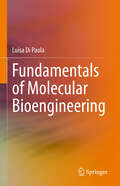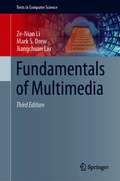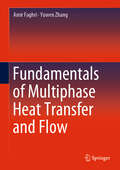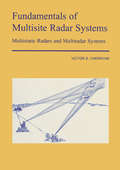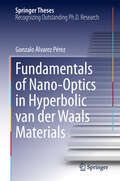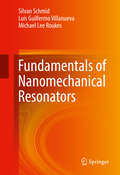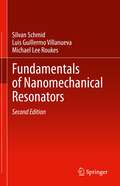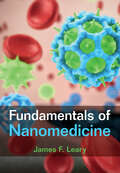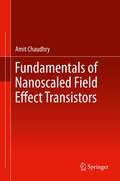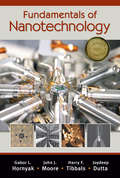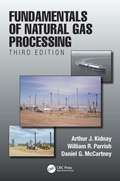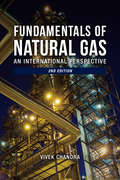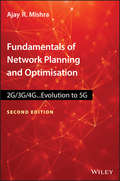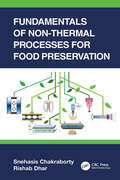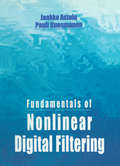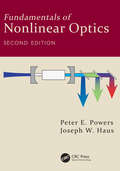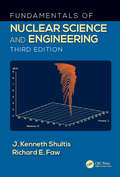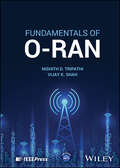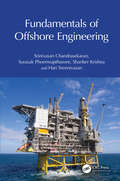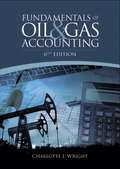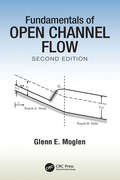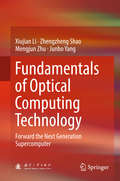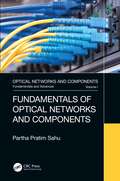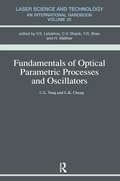- Table View
- List View
Fundamentals of Molecular Bioengineering
by Luisa Di PaolaThis textbook covers the scientific basics of molecular bioengineering, a new field where technology meets biology and chemistry, and the fundamental knowledge required for students to understand molecular mechanisms beyond biological phenomena. The textbook focuses on the role of proteins in biomolecular machinery, and it is divided into 2 parts: Part I covers the molecular thermodynamics of biological systems, and Part II discusses the computational aspects behind protein structure prediction and molecular dynamics. In the first part of the textbook, students will find comprehensive explanations of thermodynamics and statistical mechanics, which are the basis to understand how molecular properties translate into macroscopic. Part I also offers an introduction to proteins and concepts like intermolecular forces, volumetric properties of fluids, ionization equilibria and salting-out, and protein binding and protein-protein interactions. In the second part of the textbook, students will learn about protein structure prediction and analysis, systems biology and structure-based protein networks, and computational tools and approaches for molecular dynamics simulations and protein binding and protein-protein interactions.This textbook adds to the scholarly debate with a unique contribution, addressing important new areas of biophysical chemistry and molecular biophysics not covered in currently available textbooks. Given its breadth, the textbook is suitable for courses in molecular biophysics, biochemistry, physical chemistry and bioengineering, and will also appeal to researchers and professionals in these fields.Part I of this book is a translation from its Italian original manuscript done with the help of artificial intelligence. A subsequent human revision of the content was done by the author. Springer Nature works continuously to further the development of tools for the production of books and on the related technologiesto support the authors.
Fundamentals of Multimedia (Texts in Computer Science)
by Jiangchuan Liu Ze-Nian Li Mark S. DrewPREVIOUS EDITIONThis textbook introduces the “Fundamentals of Multimedia”, addressing real issues commonly faced in the workplace. The essential concepts are explained in a practical way to enable students to apply their existing skills to address problems in multimedia. Fully revised and updated, this new edition now includes coverage of such topics as 3D TV, social networks, high-efficiency video compression and conferencing, wireless and mobile networks, and their attendant technologies. Features: presents an overview of the key concepts in multimedia, including color science; reviews lossless and lossy compression methods for image, video and audio data; examines the demands placed by multimedia communications on wired and wireless networks; discusses the impact of social media and cloud computing on information sharing and on multimedia content search and retrieval; includes study exercises at the end of each chapter; provides supplementary resources for both students and instructors at an associated website.
Fundamentals of Multiphase Flow
by Christopher E. BrennenThis book is targeted to graduate students and researchers at the cutting edge of investigations into the fundamental nature of multiphase flows. It is intended as a reference book for the basic methods used in the treatment of multiphase flows. The subject of multiphase flows encompasses a vast field whose broad spectrum presents a problem for the experimental and analytical methodologies that might be appropriate for the reader's interests. The aim of Fundamentals of Multiphase Flow is to bring much of this fundamental understanding together into one book, presenting a unifying approach to the fundamental ideas of multiphase flows. The book summarizes those fundamental concepts with relevance to a broad spectrum of multiphase flows. It does not pretend to present a comprehensive review of the details of any one multiphase flow or technological context; references to such reviews are included where appropriate.
Fundamentals of Multiphase Heat Transfer and Flow
by Amir Faghri Yuwen ZhangThis textbook presents a modern treatment of fundamentals of heat and mass transfer in the context of all types of multiphase flows with possibility of phase-changes among solid, liquid and vapor. It serves equally as a textbook for undergraduate senior and graduate students in a wide variety of engineering disciplines including mechanical engineering, chemical engineering, material science and engineering, nuclear engineering, biomedical engineering, and environmental engineering. Multiphase Heat Transfer and Flow can also be used to teach contemporary and novel applications of heat and mass transfer. Concepts are reinforced with numerous examples and end-of-chapter problems. A solutions manual and PowerPoint presentation are available to instructors. While the book is designed for students, it is also very useful for practicing engineers working in technical areas related to both macro- and micro-scale systems that emphasize multiphase, multicomponent, and non-conventional geometries with coupled heat and mass transfer and phase change, with the possibility of full numerical simulation.
Fundamentals of Multisite Radar Systems: Multistatic Radars and Multistatic Radar Systems
by V S ChernyakThis is an original and comprehensive monograph on the increasingly important field of Multistatic Radar Systems. The material covered includes target detection, coordinate and trajectory parameter estimation, optimum and suboptimum detectors and external interferences. The practical problems faced by those working with radar systems are considered - most algorithms are presented in a form allowing direct use in engineering practice, and many of the results can be immediately applied to information systems containing different types of sensors, not only radars. This book is the revised international edition of Chernyak's renowned Russian textbook.
Fundamentals of Nano-Optics in Hyperbolic van der Waals Materials (Springer Theses)
by Gonzalo Álvarez PérezThis thesis focuses on the study of phonon polaritons—hybrids of infrared light and lattice vibrations—in van der Waals polar materials, particularly strongly anisotropic (hyperbolic) ones. It combines experiments, analytical theory, and numerical simulations to explore nanoscale optical phenomena that challenge our conventional understanding, such as negative reflection, anomalous refraction and polariton canalization. These studies have paved the way for practical applications in integrated flat optics, such as planar lenses and resonators for nanoscale light. The thesis also introduces the emerging field of twistoptics, aimed at controlling the propagation of light at the nanoscale by stacking slabs of van der Waals materials at different rotation angles, and introduces innovative approaches to tune polariton properties both passively and actively. In addition to providing a solid foundation for future advancements in planar nano-optical devices and helping lay the fundamentals of light-matter interactions in hyperbolic van der Waals materials, the thesis's didactic approach makes complex phenomena accessible to a broad audience.
Fundamentals of Nanomechanical Resonators
by Silvan Schmid Luis Guillermo Guillermo Villanueva Michael Lee Lee RoukesThis authoritative book introduces and summarizes the latest models and skills required to design and fabricate nanomechanical resonators with a focus on nanomechanical sensing. It also establishes the theoretical foundation for courses on micro and nanomechanics. This book takes an applied approach to nanomechanics, providing a complete set of mechanical models, including strings and membrane resonators. Also discussed are quality factors, noise issues, transduction techniques, nanomechanical sensing, fabrication techniques, and applications for all common nanomechanical resonator types. It is an ideal book for students and researchers working with micro and nanomechanical resonators.
Fundamentals of Nanomechanical Resonators
by Silvan Schmid Luis Guillermo Villanueva Michael Lee RoukesNow in an updated second edition, this classroom-tested textbook introduces and summarizes the latest models and skills required to design and optimize nanomechanical resonators, taking a top-down approach that uses macroscopic formulas to model the devices. The authors cover the electrical and mechanical aspects of nanoelectromechanical system (NEMS) devices in six expanded and revised chapters on lumped-element model resonators, continuum mechanical resonators, damping, transduction, responsivity, and measurements and noise.The applied approach found in this book is appropriate for engineering students and researchers working with micro and nanomechanical resonators.
Fundamentals of Nanomedicine
by James F. LearyThe first introductory book on the subject, this book will provide a complete grounding to this pioneering field for students and professionals across biomedical engineering, biology and medicine. It features a comprehensive overview of original work in this revolutionary field. Topics discussed include drug delivery, cell-material interaction and gene therapy, accompanied by real-world examples and over 100 illustrations. The book teaches readers how to design and test their own nanomedical systems for real-world applications in biomedical engineering, medicine and pharmacy. Presenting a thorough discussion of the science and engineering of nanomedicine, it discusses vital environmental, social and ethical impacts of this revolutionary technology. Including over 200 thought-provoking study questions, allowing the reader to self-assess their understanding, this book is a rich source of information that will be of interest and importance in nanomedicine.
Fundamentals of Nanoscaled Field Effect Transistors
by Amit ChaudhryFundamentals of Nanoscaled Field Effect Transistors gives comprehensive coverage of the fundamental physical principles and theory behind nanoscale transistors. The specific issues that arise for nanoscale MOSFETs, such as quantum mechanical tunneling and inversion layer quantization, are fully explored. The solutions to these issues, such as high-κ technology, strained-Si technology, alternate devices structures and graphene technology are also given. Some case studies regarding the above issues and solution are also given in the book.
Fundamentals of Nanotechnology
by Gabor L. Hornyak John J. Moore H.F. Tibbals Joydeep DuttaWINNER 2009 CHOICE AWARD OUTSTANDING ACADEMIC TITLE! Nanotechnology is no longer a subdiscipline of chemistry, engineering, or any other field. It represents the convergence of many fields, and therefore demands a new paradigm for teaching. This textbook is for the next generation of nanotechnologists. It surveys the field’s broad landscape, exploring the physical basics such as nanorheology, nanofluidics, and nanomechanics as well as industrial concerns such as manufacturing, reliability, and safety. The authors then explore the vast range of nanomaterials and systematically outline devices and applications in various industrial sectors. This color text is an ideal companion to Introduction to Nanoscience by the same group of esteemed authors. Both titles are also available as the single volume Introduction to Nanoscience and Nanotechnology Qualifying instructors who purchase either of these volumes (or the combined set) are given online access to a wealth of instructional materials. These include detailed lecture notes, review summaries, slides, exercises, and more. The authors provide enough material for both one- and two-semester courses.
Fundamentals of Natural Gas Processing, Third Edition
by Arthur J. Kidnay William R. Parrish Daniel G. McCartneyOffering indispensable insight from experts in the field, Fundamentals of Natural Gas Processing, Third Edition provides an introduction to the gas industry and the processes required to convert wellhead gas into valuable natural gas and hydrocarbon liquids products including LNG. The authors compile information from the literature, meeting proceedings, short courses, and their own work experiences to give an accurate picture of where gas processing technology stands today as well as to highlight relatively new technologies that could become important in the future. The third edition of this bestselling text features updates on North American gas processing and changing gas treating requirements due to shale gas production. It covers the international nature of natural gas trade, LNG, economics, and more. To help nonengineers understand technical issues, the first 5 chapters present an overview of the basic engineering concepts applicable throughout the gas, oil, and chemical industries. The following 15 chapters address natural gas processing, with a focus on gas plant processes and technologies. The book contains 2 appendices. The first contains an updated glossary of gas processing terminology. The second is available only online and contains useful conversion factors and physical properties data. Aimed at students as well as natural gas processing professionals, this edition includes both discussion questions and exercises designed to reinforce important concepts, making this book suitable as a textbook in upper-level or graduate engineering courses.
Fundamentals of Natural Gas: An International Perspective
by Vivek ChandraCleaner and more versatile than other hydrocarbons, natural gas has never had a brighter future. In this new edition of Fundamentals of Natural Gas, author Vivek Chandra thoroughly explains the massive evolution of natural gas and LNG, from technology advances and vast new reserves. As forecasts of worldwide consumption increase dramatically, this “prince of hydrocarbons” is the natural choice for electric power, heating, and as an industry feedstock. Features of the Second Edition: Growth of unconventional shale gas technology and production Rise of LNG export projects from the United States International adoption of gas-on-gas pricing Impact of LNG mega-projects and the adjusting economics of these ventures
Fundamentals of Network Planning and Optimisation 2G/3G/4G: Evolution to 5G
by Ajay R. MishraUpdated new edition covering all aspects of network planning and optimization This welcome new edition provides comprehensive coverage of all aspects of network planning in all the technologies, from 2G to 5G, in radio, transmission and core aspects. Written by leading experts in the field, it serves as a handbook for anyone engaged in the study, design, deployment and business of cellular networks. It increases basic understanding of the currently deployed, and emerging, technologies, and helps to make evolution plans for future networks. The book also provides an overview of the forthcoming technologies that are expected to make an impact in the future, such as 5G. Fundamentals of Cellular Network Planning and Optimization, Second Edition encompasses all the technologies as well as the planning and implementation details that go with them. It covers 2G (GSM, EGPRS), 3G (WCDMA) and 4G (LTE) networks and introduces 5G. The book also looks at all the sub-systems of the network, focusing on both the practical and theoretical issues. Provides comprehensive coverage of the planning aspects of the full range of today's mobile network systems, covering radio access network, circuit and packet switching, signaling, control, and backhaul/Core transmission networks New elements in book include HSPA, Ethernet, 4G/LTE and 5G Covers areas such as Virtualization, IoT, Artificial Intelligence, Spectrum Management and Cloud By bringing all these concepts under one cover, Fundamentals of Cellular Network Planning and Optimization becomes essential reading for network design engineers working with cellular service vendors or operators, experts/scientists working on end-to-end issues, and undergraduate/post-graduate students.
Fundamentals of Non-Thermal Processes for Food Preservation
by Snehasis Chakraborty Rishab DharThe ten chapters of this textbook, written in a simple but scientific language, encompass all the non-thermal treatments in-depth, from basic concepts to technological advances. The book provides complete study material in a single source including such pedagogical features as multiple-choice questions, solved numerical problems, and short questions. The book begins with a general introduction to the evolution of the non-thermal technique for food preservation. The fundamental mechanism of thermal inactivation of microorganisms and enzymes is discussed. In the following chapters, a set of seven non-thermal techniques have been discussed in detail.
Fundamentals of Nonlinear Digital Filtering (Electronic Engineering Systems Ser. #8)
by Jaakko Astola Pauli KuosmanenFundamentals of Nonlinear Digital Filtering is the first book of its kind, presenting and evaluating current methods and applications in nonlinear digital filtering. Written for professors, researchers, and application engineers, as well as for serious students of signal processing, this is the only book available that functions as both a reference handbook and a textbook. Solid introductory material, balanced coverage of theoretical and practical aspects, and dozens of examples provide you with a self-contained, comprehensive information source on nonlinear filtering and its applications.
Fundamentals of Nonlinear Optics, Second Edition
by Joseph W. Haus Peter E. PowersPraise for the 1st Edition: "well written and up to date…. The problem sets at the end of each chapter reinforce and enhance the material presented, and may give students confidence in handling real-world problems." ?Optics & Photonics News "rigorous but simple description of a difficult field keeps the reader’s attention throughout…. serves perfectly for an introductory-level course." ?Physics Today This fully revised introduction enables the reader to understand and use the basic principles related to many phenomena in nonlinear optics and provides the mathematical tools necessary to solve application-relevant problems. The book is a pedagogical guide aimed at a diverse audience including engineers, physicists, and chemists who want a tiered approach to understanding nonlinear optics. The material is augmented by numerous problems, with many requiring the reader to perform real-world calculations for a range of fields, from optical communications to remote sensing and quantum information. Analytical solutions of equations are covered in detail and numerical approaches to solving problems are explained and demonstrated. The second edition expands the earlier treatment and includes: A new chapter on quantum nonlinear optics. Thorough treatment of parametric optical processes covering birefringence, tolerances and beam optimization to design and build high conversion efficiency devices. Treatment of numerical methods to solving sets of complex nonlinear equations. Many problems in each chapter to challenge reader comprehension. Extended treatment of four-wave mixing and solitons. Coverage of ultrafast pulse propagation including walk-off effects.
Fundamentals of Nuclear Science and Engineering
by J. Kenneth Shultis Richard E. FawFundamentals of Nuclear Science and Engineering, Third Edition, presents the nuclear science concepts needed to understand and quantify the whole range of nuclear phenomena. Noted for its accessible level and approach, the Third Edition of this long-time bestselling textbook provides overviews of nuclear physics, nuclear power, medicine, propulsion, and radiation detection. Its flexible organization allows for use with Nuclear Engineering majors and those in other disciplines. The Third Edition features updated coverage of the newest nuclear reactor designs, fusion reactors, radiation health risks, and expanded discussion of basic reactor physics with added examples. A complete Solutions Manual and figure slides for classroom projection are available for instructors adopting the text.
Fundamentals of O-RAN
by Nishith D. Tripathi Vijay K. ShahComprehensive reference on O-RAN technology, covering its history, architecture, security, ecosystem, and more, with didactic resources included throughout Discussing both basic and advanced concepts, Fundamentals of O-RAN delivers a comprehensive summary of O-RAN, covering its history, architecture, control loops and microservices (i.e., xApps and rApps), security, ecosystem, R&D initiatives, and challenges and evolution toward 6G. The book not only includes key theoretical principles of O-RAN, but also provides a framework for the reader to carry out guided hands-on exercises through online auxiliary materials. Homework problems and review questions are included in online auxiliary materials to reinforce learning. The book includes instructions on how to create xApps, which are expected to be one of the most promising aspects of O-RAN; for example, by working with an end-to-end O-RAN system using a network slicing functionality where the rApp provides slicing specified policies to the xApp which then allocates the base station’s spectrum resources based on the slicing policy to each user (belonging to a certain slice). Readers will also gain an understanding of cellular networks, particularly radio access networks, software virtualization, and software-defined networking concepts, and the knowledge needed to design, build, and test a 5G O-RAN system. Some of the sample topics explored in Fundamentals of O-RAN include: RAN evolution from black box 4G RAN to software-based and virtualized RAN (vRAN) Components of the O-RAN architecture including SMO, Non-RT RIC, Near-RT RIC, O-CU-CP, O-CU-UP, O-DU, O-RU, and O-Cloud xApp design and prototyping from scratch using open cellular software, srsRAN and O-RAN Software Community (OSC) software. Examination of various security dimensions inherent in the O-RAN architecture. Testing and integration, covering Open Test and Integration Centers (OTICs), global PlugFests, certification and badging, and end-to-end test specifications Work Groups (WGs), including WG1 to WG11, and focus groups, with information on how to obtain WG specifications Fundamentals of O-RAN is an essential reference for the workforce of tomorrow’s cellular industry, including graduate students, teachers, researchers, faculty members, engineers, and employees involved in the field of wireless networks, especially radio networks.
Fundamentals of Offshore Engineering
by Srinivasan Chandrasekaran Surasak Phoemsapthawee Shanker Krishna Hari SreenivasanFundamentals of Offshore Engineering addresses the basics of design for offshore oil and gas production systems and examines the health, safety, and environmental (HSE) aspects in the oil and gas industry with emphasis toward safety measures in design and operations. It also covers fundamental issues of crude oil and natural gas exploration and extraction and also includes coverage of seismic surveys and green energy systems. Details of offshore platforms, describing the types, historical development, basics of analysis and design, environmental loads, and potential hazards are also provided. The book serves as a useful resource for universities that teach offshore engineering to senior undergraduate and graduate students as well as a guide for practicing engineers. Includes coverage of wave loads, wind loads, ice loads, and fire loads on structures. Discusses offshore pipelines and subsea engineering to help readers understand the fundamentals of petroleum production and related pipeline installation.
Fundamentals of Oil & Gas Accounting
by Charlotte J. WrightProfessor Charlotte Wright updates her indispensable accounting book for the oil and gas industry in this revised & expanded sixth edition. The past several years have seen significant changes in the accounting and disclosure rules for the industry. While the book has thorough updates throughout, there are new industry issues specifically addressed from the accounting perspective. Some of the significant updates and new material include: Discussion of the significance of shale and unconventional production as it relates to accounting principles New definitions of reserves from the Securities and Exchange Commission, and the impact on accounting processes All citations and references align with the updated authoritative literature from the Financial Accounting Standards Board A new chapter discussing specific issues previously unaddressed regarding property valuation in the industry New, and updated, end-of-chapter problems
Fundamentals of Open Channel Flow
by Glenn E. MoglenThis second edition of Fundamentals of Open Channel Flow focuses on theory followed by clear, fully-solved examples, and practical computational tools such as spreadsheets and industry standard software. It builds on a foundation in fluid mechanics and offers the basics of a first course in open channel flow for senior undergraduates or graduate students: energy, momentum, friction, and gradually varied flow, both qualitative and quantitative. This edition provides more coverage of design applications, including culvert design, a wider range of channel shapes, and an update of the US Corps of Engineers’ HEC-RAS program. It shows how a few simple equations can solve a range of basic problems. The energy-depth and momentum-depth relationships are examined graphically and the book's website offers unique animations showing actual flow dynamics of some transient flow problems, as well as solutions to end-of-chapter problems and PowerPoint slides for instructors.
Fundamentals of Optical Computing Technology: Forward The Next Generation Supercomputer
by Xiujian Li Zhengzheng Shao Mengjun Zhu Junbo YangThis book presents the principles, experimental technologies, up-to-date research findings and applications of various optical-computing technologies and devices. It also discusses semiconductor multiple quantum well (MQW) photoelectronic devices, vertical-cavity surface-emitting lasers (VCSELs), lasers, micro optical elements and diffractive optical elements, optical storage, optical parallel interconnections, and optical-buffer technology as the main technologies for optical computing. Furthermore, it explores the potential of optical-computing technology. It offers those involved in optical design, photonics, and photoelectronic research and related industries insights into the fundamentals and theories of optical computing, enabling them and to extend and develop the functions of fundamental elements to meet the requirement of optical-computing systems.
Fundamentals of Optical Networks and Components
by Partha Pratim SahuThis book is intended as an undergraduate/postgraduate level textbook for courses on high-speed optical networks as well as computer networks. Nine chapters cover the basic principles of the technology and different devices for optical networks, as well as processing of integrated waveguide devices of optical networks using different technologies. It provides students, researchers and practicing engineers with an expert guide to the fundamental concepts, issues and state-of-the-art developments in optical networks. It includes examples throughout all the chapters of the book to aid understanding of basic problems and solutions. Presents basics of the optical network devices and discusses latest developments Includes examples and exercises throughout all the chapters of the book to aid understanding of basic problems and solutions for undergraduate and postgraduate students Discusses different optical network node architectures and their components Includes basic theories and latest developments of hardware devices with their fabrication technologies (such as optical switch, wavelength router, wavelength division multiplexer/demultiplexer and add/drop multiplexer), helpful for researchers to initiate research on this field and to develop research problem-solving capability Reviews fiber-optic networks without WDM and single-hop and multi-hop WDM optical networks P. P. Sahu received his M.Tech. degree from the Indian Institute of Technology Delhi and his Ph.D. degree in engineering from Jadavpur University, India. In 1991, he joined Haryana State Electronics Development Corporation Limited, where he has been engaged in R&D works related to optical fiber components and telecommunication instruments. In 1996, he joined Northeastern Regional Institute of Science and Technology as a faculty member. At present, he is working as a professor in the Department of Electronics and Communication Engineering, Tezpur Central University, India. His field of interest is integrated optic and electronic circuits, wireless and optical communication, clinical instrumentation, green energy, etc. He has received an INSA teacher award (instituted by the highest academic body Indian National Science Academy) for high level of teaching and research. He has published more than 90 papers in peer-reviewed international journals, 60 papers in international conference, and has written five books published by Springer Nature, McGraw-Hill. Dr Sahu is a Fellow of the Optical Society of India, Life Member of Indian Society for Technical Education and Senior Member of the IEEE.
Fundamentals of Optical Parametric Processes and Oscillations
by Alice M. TangThis study looks at the basic principles of optical parametric processes and recent results on the rapidly developing optical parametric device technology. The theoretical basis of stimulated and spontaneous optical parametric processes and detailed design considerations of optical parametric oscillators and amplifiers are discussed, followed by a review of the materials properties of the most important nonlinear optical crystals for such applications. It concludes with a review of the recent developments on practical low-repetition rate nanosecond optical parametric oscillators and broadly tunable high-repetition rate continuous-pulse-train femtosecond optical parametric oscillations from the uv to the mid ir.
